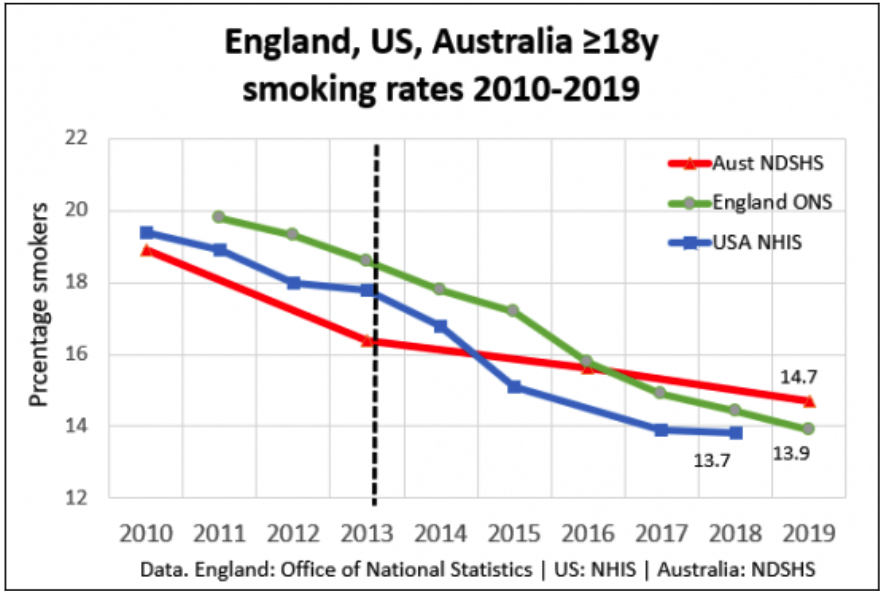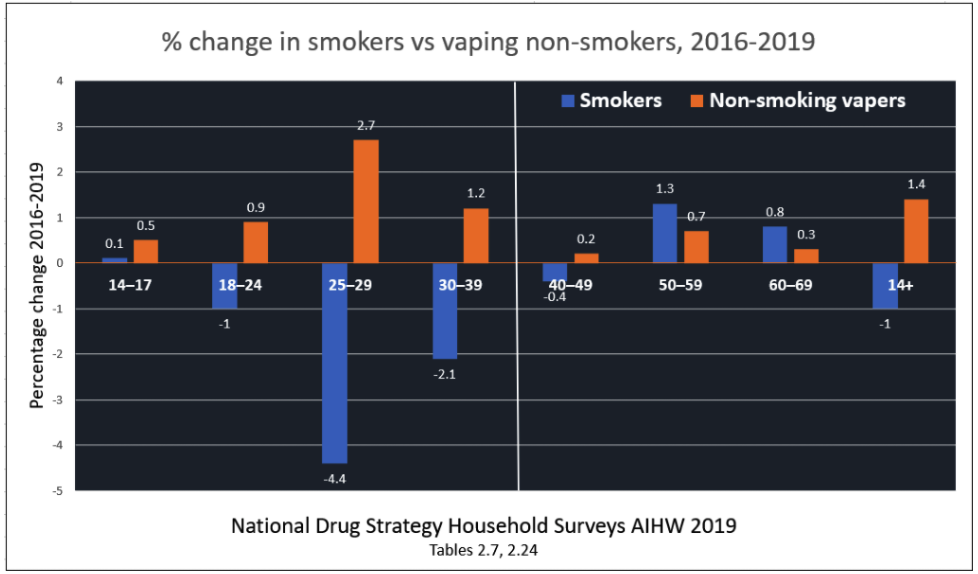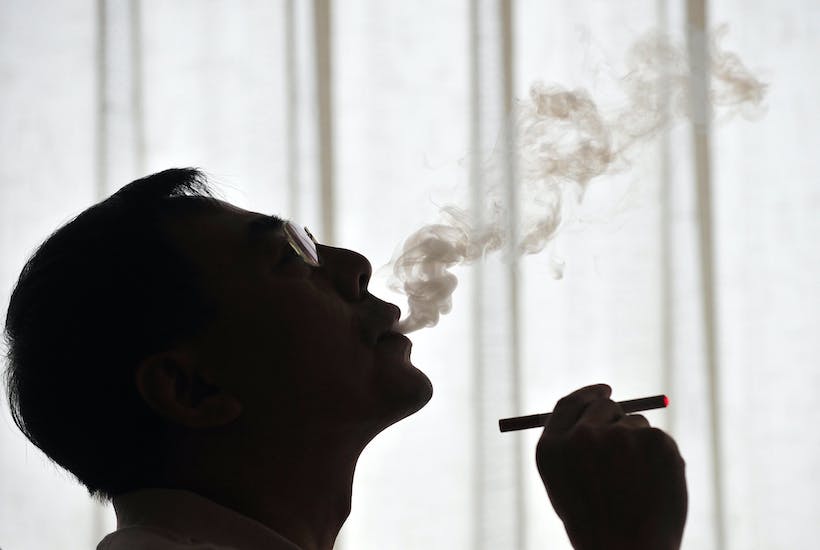There was a deafening roar last week caused by Australia’s tobacco control experts congratulating themselves on the latest national smoking results. You could be forgiven for believing that Australia is a world leader in reducing smoking rates and that vaping is a major threat to public health. However, the figures released in the 2019 National Drug Strategy Household Survey tell a very different story.
Since 2013 adult smoking rates in Australia have fallen by a glacial 0.3% per year, less than half the rate of many other western countries. During the same period, adult smoking rates have declined by 1% per year in the US (2013-2018) and by 0.8% per year in England (2013-2019). The evidence suggests that the high uptake of vaping nicotine is a major contributor to this rapid decline.

Decline in adult smoking rates in England, US and Australia 2010-19
Australia’s smoking failure also conceals a disturbing underbelly of social injustice. People in the lowest socio-economic quintile are two and a half times more likely to smoke than those in the highest quintile (21.2% vs 8.2%) and this gap is increasing. Disadvantaged people also smoke twice as many cigarettes daily.
Disturbingly high smoking rates persist in Indigenous people, those living with mental illness, the homeless, people who use drugs and those living in remote areas.
The survey found that smokers in their 20s and 30s are quitting, but smoking rates in the over–40s remained unchanged since 2016. Two in three smokers in this age range will die from a smoking-related disease. Most have tried repeatedly to quit unsuccessfully and may benefit from new and effective strategies, such as vaping.
Smoking seems to have fallen off the political radar in Australia. The Health Minister allocated a miserly $30 million for a 4-year plan to reduce smoking rates in 2019, a tiny fraction of the $17 billion in tobacco excise collected every year. Tobacco control experts still lobby for the good old days of mass media campaigns, but budgetary constraints guarantee this will not occur soon.
Nicotine vaping could be part of the solution
Despite a de facto ban on nicotine liquid, vaping has continued to flourish in Australia. According to the 2019 survey, 2.5% of the population now vapes, double the rate of 2016. This compares to 5.7% in Great Britain and 3.2% in the US. There are now more than half a million Australian vapers.
It is increasingly clear that rising vaping rates are contributing to falls in smoking. One striking finding in the latest Australian survey is that the age groups with the greatest falls in smoking rates (25-39 year olds) also had the largest increases in vaping rates, as the following graph shows.

Change in smoking rate compared with change in vaping rates, by age group 2016-19
It is likely that vaping is contributing to the reduction in smoking in these age groups, either by helping smokers to quit or diverting those who would otherwise have taken up smoking to a safer alternative.
This is not surprising. Vaping nicotine is the most popular quitting aid globally and the most effective. It provides the nicotine smokers are addicted and replicates the hand-to-mouth ritual and sensations of smoking. However, vaping does not generate the thousands of toxic chemicals in tobacco smoke such as tar and carbon monoxide from burning tobacco that cause almost all the harm to health.
Vaping is at least 95% less harmful than smoking. It is a legitimate alternative for smokers who are unable or unwilling to quit smoking with conventional treatments and who will otherwise continue to smoke.
Is there a youth vaping epidemic?
In Australia in 2019, 1.8% of youth (14-17 years old) were current vapers. Importantly, vaping is largely confined to youth who smoke. Many use vaping to help them quit, to prevent relapse to smoking and because it is less harmful than smoking.
Vaping is rare in never-smoking Australian youth. Less than one in two hundred young people who have never–smoked currently vape. Most vaping by non-smokers is experimental or transient, although the frequency of vaping is not available in this survey. However, in the US 70% of never-smoking youth who vaped did so on only 1-5 days in the previous month
Despite the media hype about a “youth vaping epidemic”, vaping is reducing youth smoking rates where it is widely available, such as in the US and UK. In the US, the decline in youth smoking accelerated by 2-4 times after 2014 when vaping became popular. Rather than being a gateway into smoking, vaping is a net gateway out of smoking for young people.
In the past, teens rebelled by smoking. Increasingly in modern times they are turning to vaping instead. Vaping is not risk-free (nothing is) but it is far safer than smoking.
Australia is the only western democracy to ban the sale and use of nicotine for vaping and the Health Minister wants to restrict vaping further. A better plan for public health is to promote vaping as a safer alternative for smokers who cannot quit, like governments of New Zealand and the United Kingdom. Sensible, risk-proportionate regulation will restrict access to youth and maintain high quality and safety standards.
Smoking is declining at a snail’s pace in Australia. Vaping has the potential to accelerate the decline and could save hundreds of thousands of lives.
University of New South Wales Conjoint Associate Professor Colin Mendelsohn is the Founding Chairman of the Australian Tobacco Harm Reduction Association.
Author’s conflict of interest statement: I have never received any payments from tobacco or e-cigarette companies and have no commercial connections with either. ATHRA is funded by public donations and does not accept donations from tobacco companies or their subsidiaries. ATHRA accepted financial support from the small vape retail sector to establish the charity in 2017 but has not accepted industry funding since March 2019. ATHRA’s funding policy is outlined here.
Got something to add? Join the discussion and comment below.
Got something to add? Join the discussion and comment below.
Get 10 issues for just $10
Subscribe to The Spectator Australia today for the next 10 magazine issues, plus full online access, for just $10.


























Comments
Don't miss out
Join the conversation with other Spectator Australia readers. Subscribe to leave a comment.
SUBSCRIBEAlready a subscriber? Log in